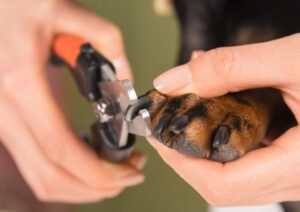The How And Why Of Trimming Your Dog’s Toenails
 One of the most difficult things to do with your dog is to trim their nails; especially if they don’t like having their nails cut. Trimming your dog’s nails is an important grooming task that helps them stay happy and healthy. When their nails grow too long, health problems could occur. Dogs that run around on hard surfaces like concrete or blacktop, their nails are often worn down naturally. For dogs that spend most of their time indoors or running around on soft surfaces, their nails don’t get worn down regularly.
One of the most difficult things to do with your dog is to trim their nails; especially if they don’t like having their nails cut. Trimming your dog’s nails is an important grooming task that helps them stay happy and healthy. When their nails grow too long, health problems could occur. Dogs that run around on hard surfaces like concrete or blacktop, their nails are often worn down naturally. For dogs that spend most of their time indoors or running around on soft surfaces, their nails don’t get worn down regularly.
Nails that are too long are at risk of being torn off. This can result in an injury that could require veterinary care if it is serious enough. Longer nails also make it harder for dogs to walk around comfortably. If a dog’s nails hit the floor constantly as they walk, more pressure is put onto the nail bed that can cause discomfort that forces your dog to distribute their weight differently while they walk. In the end, this all can cause the way their toe and paw joints are aligned to be affected in a negative way.
If your dog is not used to having their nails trimmed, one should start getting them used to the clippers and having their paws handled. You can do this by forming a positive association with it by rewarding them with treats and praise until they allow you to clip their nails without getting too nervous.
There are several types of dog nail trimmers including scissors, guillotine-type, and grinder tools designed for dogs. You can use whatever type you are most comfortable with, or whatever works best for your dog. It is a good idea to have some sort of styptic power or other clotting power on hand to stop bleeding in case you cut a nail too short.
To trim your dog’s nails, pick up one paw, and firmly but gently place your thumb on the pad of a toe and your forefinger on the top of the toe on the skin above the nail. Make sure none of your dog’s fur is in the way. Next, push your thumb slightly up and backward on the pad, while pushing your forefinger forward. This extends the nail. Clip only the tip of the nail, straight across. Include the declaws which are located on the inner side of the paw. Lastly, avoid clipping past the curve of the nail. This helps you avoid hitting the quick, the pink area of the nail that contains the blood vessels. If you were to hit the quick, it is extremely painful and will bleed. On dogs with dark nails, there will be a chalky white ring marking the quick.
Trimming your dog’s nails can be a difficult task that you and your dog do not like. With praise and positive association, trimming time can grow to be a painless task for you and your dog. If you have any questions, feel free to contact Dr. Olsen at Olsen Veterinary Clinic at 618-656-5868.
